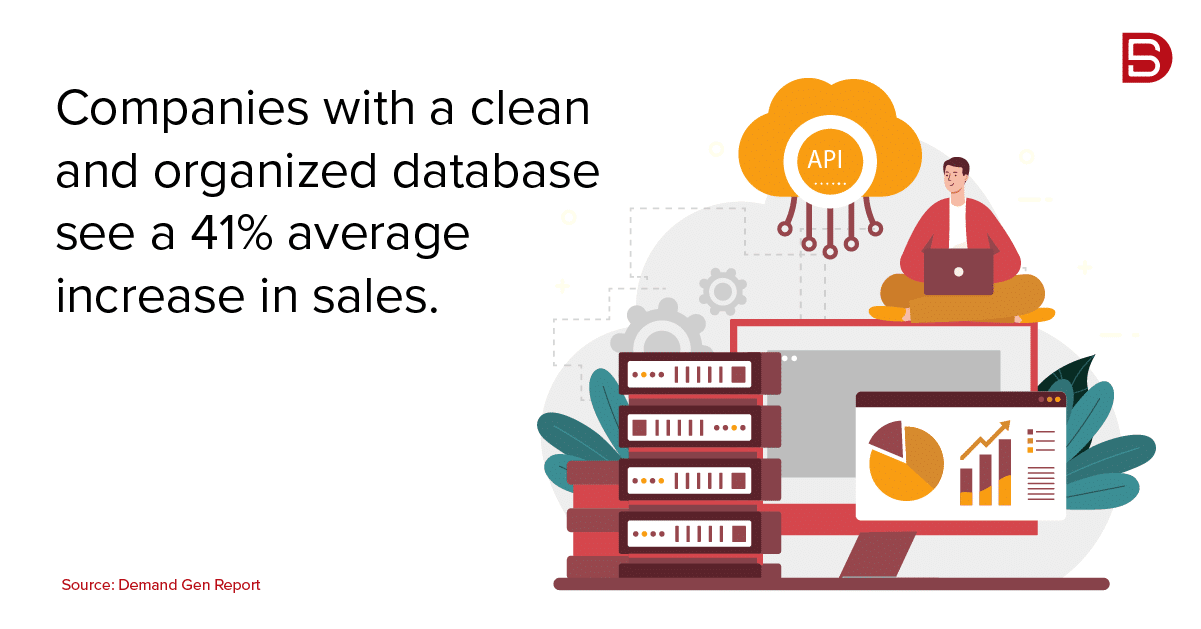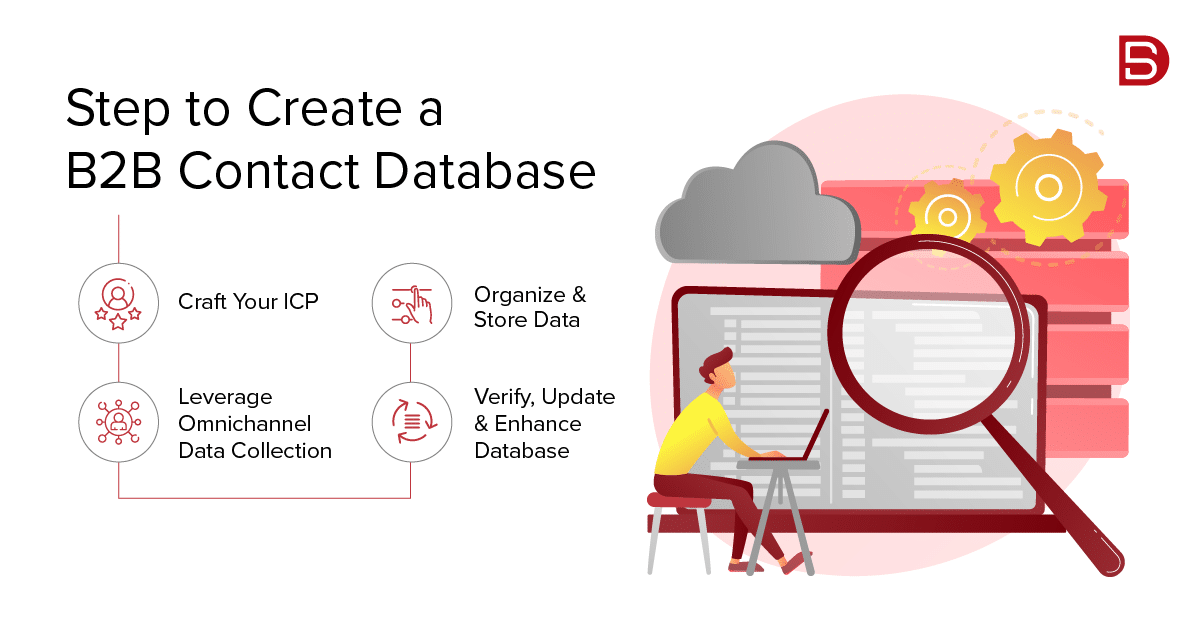Who’s on your radar for outreach today? Ideally, your B2B contact database should have the answer: a list of contacts ready to move through your sales funnel until they convert into customers.
Unfortunately, many businesses waste precious time and miss out on valuable opportunities by relying on inaccurate and outdated data. That spells trouble for any company! In this blog, we will discuss what a B2B contact database is, why it’s important, and offer tips for setting one up effectively. Let’s dive in and uncover the secrets to success in today’s competitive market.
What is a B2B Contact Database?
A robust B2B contact database is the backbone of a marketing team’s efforts, providing valuable insights into potential customers. It’s not just about accuracy; it’s also about granularity, ensuring that the database contains relevant details specific to target segments within a company. This specificity allows for more targeted and effective marketing campaigns, ultimately driving better results and ROI.
In addition to contact numbers and email addresses, a well-rounded B2B database or contact list should include enriched data such as geographic (Location-based information like country and city), demographic (Age, job title, company size. etc.), and technographic data. (Technology tools, hardware & software landscape, etc.).
And while data is pivotal in driving sales for any company, numerous businesses struggle to sustain a steady flow. As a result, they risk losing their competitive edge in the market due to insufficient contacts and information. This predicament underscores the critical importance of prioritizing data management strategies, which brings us to the next part.
Role of a B2B Contact Database in Driving Business ROI
Most B2B companies rely on marketing campaigns to connect with the right accounts across key markets. For these campaigns to thrive, they require a steady stream of thoroughly validated B2B leads, complete with phone numbers and email addresses. This ensures marketing efforts are targeted and impactful, leading to successful engagement and conversion.
Gone are the days of scattershot B2B prospecting. Nowadays, databases go beyond basic contact information, offering demographic, technographic, and geographic data, including job titles, department roles, seniority levels, and even location specifics. With this rich pool of insights, marketers can take a laser-focused approach to campaigns, saving time and resources that might otherwise be wasted on chasing a wild goose. This helps uncover prospects, nurture leads, and seal the deal with potential buyers.
Steps to Craft a Robust B2B Contact Database
Here are the key steps to create a quality B2B contact list from scratch:
1. Craft Your Ideal Customer Profile
To begin with, it’s crucial to define the ideal customer profile (ICP). This profile serves as a blueprint for identifying target accounts that align best with the solutions offered by the business. By focusing on accounts that are more inclined to purchase the company’s products or services, B2B demand generation efforts are streamlined, ensuring that sales reps concentrate their efforts on leads with higher conversion potential and avoid pursuing those unlikely to convert.
It’s up to the B2B sales teams to analyze the characteristics and behaviors of their current customers to help construct an effective ICP by considering the following:
- Industries they operate in
- Company locations
- Employee count and revenue
- Key pain points they experience
- Unique selling points distinguishing the product or service from competitors
- Timeline for observing results
In addition to pinpointing the ideal buyer characteristics, companies must also define the ‘Total Addressable Market (TAM),’ which represents the overall demand in the market for the products or services offered by the company.
2. Leverage Omnichannel Data Collection
Building a precise B2B contact database often feels like a never-ending internet scavenger hunt. Nowadays, businesses gather vast amounts of B2B company data across various digital touchpoints, including website visits, content downloads, and email subscriptions. Here are some key channels by which you can fuel your B2B contact database:
- Employing LinkedIn Sales Navigator to search and filter companies aligning with the enterprise’s ideal customer profile.
- Capitalizing on webinars, virtual events, and online conferences to engage with other businesses, identify decision-makers and influencers, and acquire high-quality prospects.
- Partnering with a trusted B2B data solutions provider to acquire verified email addresses and prospects’ phone numbers across various companies.
3. Organize & Store Data
This step is crucial for ensuring your B2B contact database remains accessible and manageable. Here’s how you can streamline this:
Centralized Location: Choose a single, centralized location to store all the data you’ve collected about your prospects. This could be a customer relationship management (CRM) platform specifically designed to organize and manage customer data. Alternatively, you could use a spreadsheet or dedicated database software, depending on the size and complexity of your database.
Structured Format: Organize your data in a structured format that is easy to navigate and understand. For example, in a CRM platform, you can create custom fields to capture specific information about each prospect, such as company name, contact details, industry, and job title. In a spreadsheet or database software, you can use columns and rows to organize your data similarly.
Data Segmentation: Consider segmenting your data into different categories or groups based on relevant criteria, such as industry, company size, or geographic location. This allows you to target specific audience segments more effectively and tailor your marketing and sales efforts accordingly.
4. Verify, Update & Enrich Database
The final step in crafting the best B2B contact database is to actively validate and update the gathered data, ensuring its accuracy by refining the information. This helps marketers gain a comprehensive understanding of the prospects listed. Additionally, enriching the data with additional information, such as email addresses, phone numbers, and social media profiles, further enhances the database’s effectiveness. With enriched data, businesses can better segment their audience, prioritize leads, and customize outreach strategies for personalized customer engagement.
Conclusion
Building a B2B marketing database from the ground up might seem like a daunting task, but it’s key to keeping your customer relationships healthy and uncovering new leads. Having precise customer records lets you communicate effectively with your audience and lowers the chances of getting blacklisted. Remember, neglecting your database can have severe repercussions for your email account, so regularly check and update its accuracy.
If you wish to ensure your marketing efforts hit the mark, reach out to us at marketing@datamaticsbpm.com. Let’s discuss how our accurate B2B data solutions can fuel the success of your next campaign.
 Select an element to maximize. Press ESC to cancel.
Select an element to maximize. Press ESC to cancel.
Henry Romano




